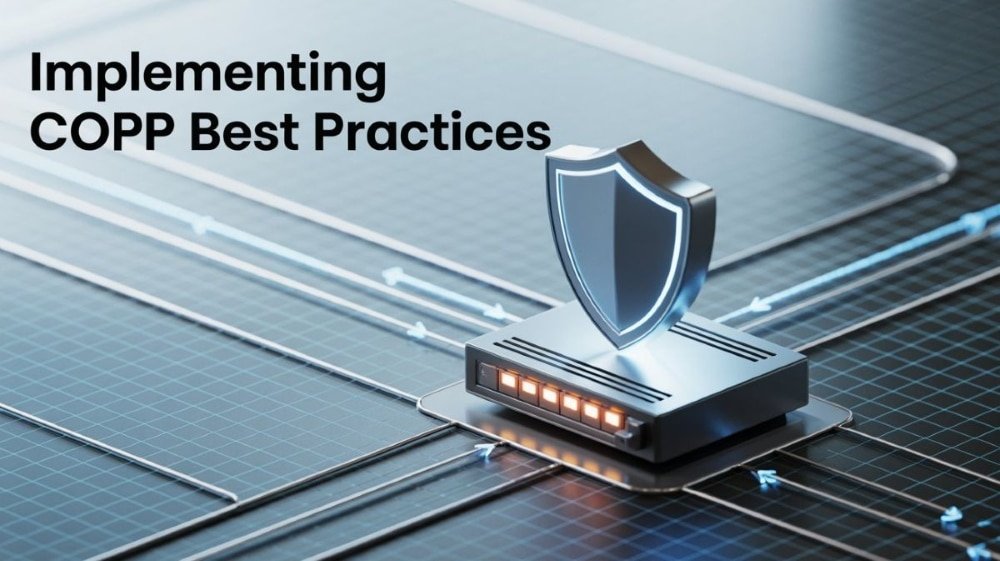Control plane protection is essential for securing today’s enterprise networks. It defends the control plane—the core of any network device responsible for routing, protocol communication, and device management—from threats that can disrupt availability and performance. As networks become more dynamic and exposed to various attacks, especially DoS and protocol abuse, protecting the control plane is no longer optional but a foundational requirement for network security and reliability.
If you want to pursue CCNP Security training, learning about Control Plane Protection (CoPP) is a must. It not only prepares you for the exam objectives but also equips you to implement strong, real-world network defense strategies in modern infrastructures.
Understanding the Control Plane
The control plane is the logical brain of a router or switch. It processes traffic that is destined to
the device itself, such as:
- Routing updates (OSPF, EIGRP, BGP)
- Network discovery protocols (CDP, LLDP)
- Device management traffic (SSH, SNMP, NTP)
- ARP, ICMP, and other signaling traffic.
Unlike the data plane, which handles packet forwarding, the control plane determines how data should move across the network. It relies on CPU resources and is not optimized for high-throughput processing, making it vulnerable to overload or targeted attacks.
Why CoPP Is Essential
Without protection, the control plane can become overwhelmed due to:
- Denial of Service (DoS) attacks
- Flooding of control protocols like ICMP or ARP
- Misconfigurations in edge devices
- Protocol abuse (e.g., rogue BGP updates)
A compromised control plane can lead to routing flaps, network downtime, or total loss of administrative access. CoPP ensures only trusted, rate-limited, and classified traffic reaches the control plane—safeguarding stability during both normal and abnormal conditions.
Key Benefits of CoPP
- Increased network resilience: Even under high load, critical processes stay functional.
- Improved device performance: Unwanted or malicious traffic is filtered before consuming CPU cycles.
- Granular control: Protocol-level filtering and policing allow precise traffic shaping.
- Better visibility: Traffic hitting the control plane is monitored and logged.
Core Concepts of CoPP
To implement CoPP effectively, one must understand its building blocks:
- Traffic Classification: Identify and segment traffic by type and importance (e.g., BGP, OSPF, SSH).
- Policy Definition: Set thresholds, rate limits, and actions (permit, drop, police) per traffic class.
- Global Application: CoPP policies apply device-wide, not per interface.
- Prioritization: Essential traffic gets priority; untrusted traffic is controlled or dropped.
Best Practices for Implementing CoPP
The table below outlines the most important best practices for building a robust CoPP strategy:
| Best Practice | Description | Importance |
| Prioritize Critical Traffic | Identify protocols like BGP, OSPF, SSH as essential | Maintains routing and device manageability |
| Segment by Trust Level | Categorize traffic as trusted (internal), untrusted (external), and management | Enables tiered filtering and protection |
| Use Specific ACLs | Avoid broad “any any” matches; use tightly scoped filters | Prevents legitimate traffic disruption |
| Apply Rate Limits (Policing) | Control the rate of packets per class | Protects against volumetric DoS |
| Monitor and Log Events | Regularly inspect CoPP policy hits and drops | Enables early detection of anomalies |
| Audit Policies Periodically | Update classes and thresholds based on traffic patterns | Ensures continued relevance and security |
| Test in Lab Environments | Simulate traffic before production deployment | Reduces chances of unintentional blocking |
| Avoid Over-Policing | Ensure policies don’t drop critical control messages | Preserves routing adjacency and stability |
How CoPP Differs from Interface ACLs
While interface ACLs are used to filter traffic through or from the device, **CoPP is designed specifically for traffic to the device—typically handled by the control plane. This distinction ensures that:
- Network control protocols are treated with special care
- Unnecessary management or probing traffic is filtered early
- Only authorized sources interact with the device CPU
Layered CoPP Strategy
A tiered approach to CoPP enhances security and performance. Here’s how to categorize traffic:
High Priority (Critical Control Protocols)
- BGP, OSPF, HSRP, EIGRP
- Require minimal policing or rate-limiting
- Necessary for routing and redundancy
Medium Priority (Management and Infrastructure)
- SSH, SNMP, NTP, CDP, LLDP
- Moderate rate-limiting
- Important for device access and inventory
Low Priority (Untrusted or Generic)
- ICMP, traceroute, unknown UDP
- Heavily rate-limited or dropped
- Often used for reconnaissance or DoS attempts
CoPP in the Enterprise
Organizations deploying CoPP across their infrastructure should consider:
- Centralized policy management: Use templates or configuration automation for consistency
- Cross-device compatibility: Coordinate rules among border devices, switches, and routers
- Policy version control: Track changes and rollback as needed
- Integration with SIEM tools: Send CoPP logs to your SOC for real-time analysis
For larger networks or ISPs, CoPP may be complemented with CPPr (Control Plane Protection with granular control) or hardware-accelerated filters in high-end devices.
Monitoring CoPP Effectiveness
To ensure CoPP policies are working:
- Review traffic counters periodically
- Look for policy hit counts, which indicate matching traffic
- Set alerts for exceeded thresholds or drops
- Adjust policies if legitimate traffic is being restricted
Regular reviews will help refine your protection profile over time.
Common Mistakes to Avoid
- Too restrictive policies causing control plane isolation
- Neglecting low-rate floods like slow ICMP-based attacks
- Failure to update filters as network services evolve
- No logging—making troubleshooting difficult
- Blind copy-paste of vendor defaults without traffic analysis
These can lead to serious service degradation or outages—especially in production environments.
Conclusion
Control Plane Protection (CoPP) is more than just a security feature—it’s a critical part of maintaining network health and resiliency. If you want to build a strong foundation in network security, protecting the control plane is no longer optional. With proper classification, rate limiting, monitoring, and strategic policy deployment, CoPP becomes the first line of defense against both internal misconfigurations and external threats.
If you want to prepare for CCNP Security training, gaining a solid understanding of CoPP should be a key focus. It not only helps you align with the certification objectives but also prepares you to handle real-world challenges in securing modern network infrastructures.







